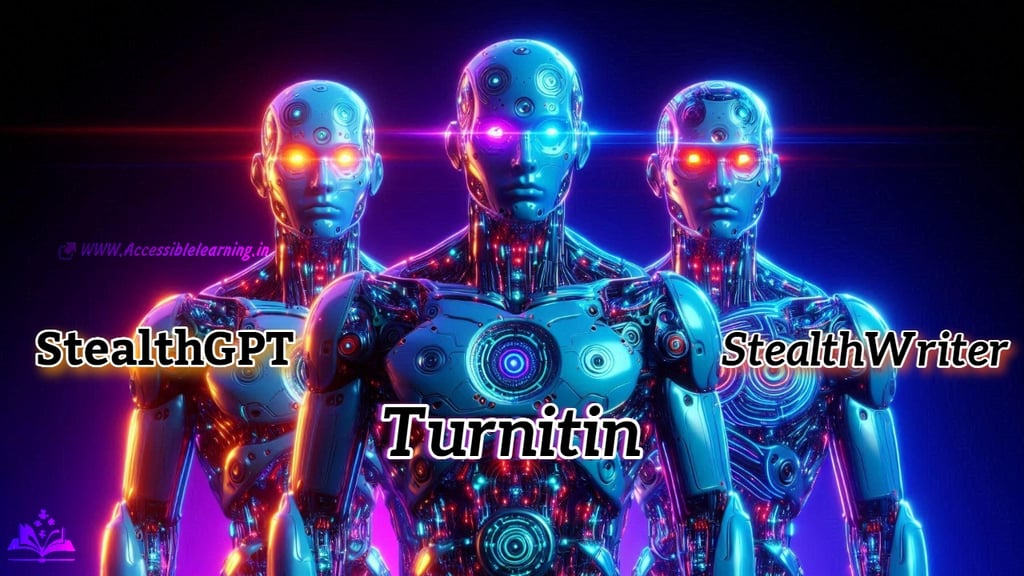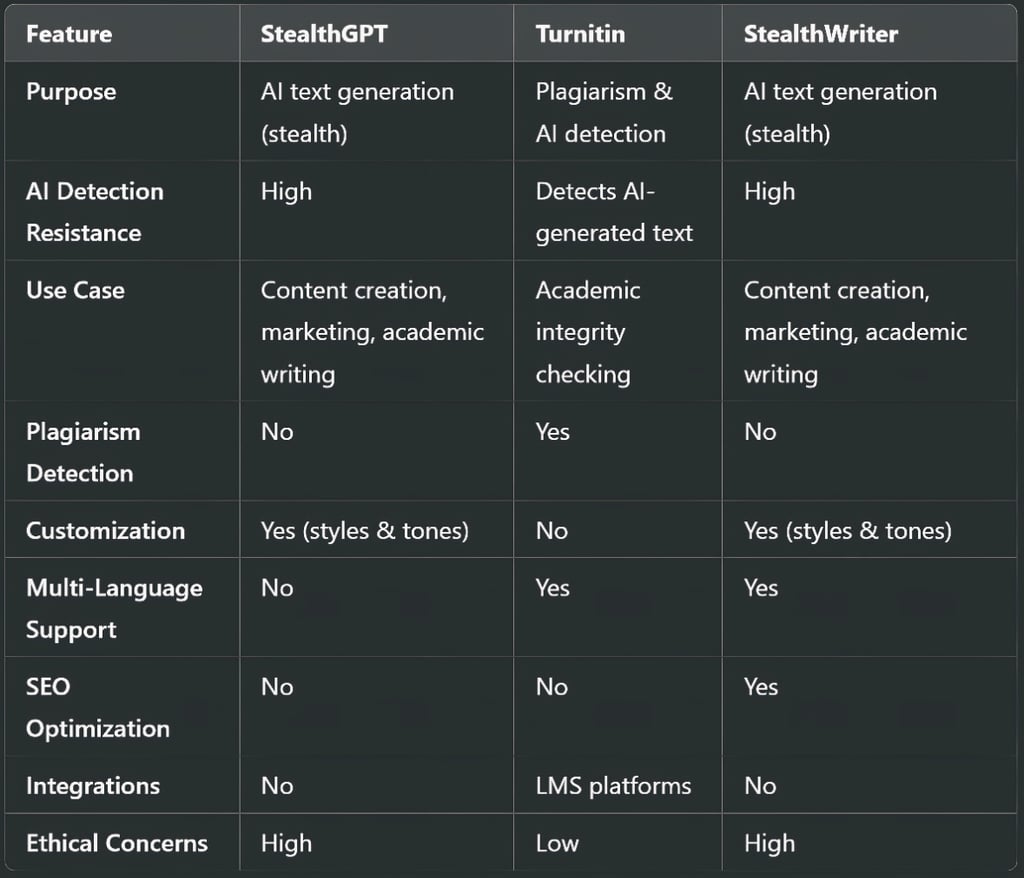
StealthGPT vs Turnitin vs StealthWriter: Which One Should You Use?
StealthGPT vs Turnitin vs StealthWriter A detailed comparison of AI-powered text generation and plagiarism detection tools. Explore their features, advantages, and ethical considerations to determine which tool best suits your needs.
AI ASSISTANTAI/FUTUREEDUCATION/KNOWLEDGEEDITOR/TOOLS
Sachin K Chaurasiya
2/28/20255 min read


In an era where AI-generated content is on the rise, tools that either generate AI-driven text or detect AI-written material are becoming crucial in academia and content creation. Among the most notable names in this space are StealthGPT, Turnitin, and StealthWriter. Each tool serves a different purpose—StealthGPT and StealthWriter focus on AI-driven text creation, while Turnitin specializes in plagiarism and AI detection. But how do they compare? Let's take a deep dive into their functionalities, strengths, and best use cases.
StealthGPT: The AI-Powered Undetectable Content Generator
StealthGPT is an AI-powered content generation tool designed to bypass AI detection mechanisms. It creates human-like text that appears natural, making it difficult for AI detectors to flag it as machine-generated.
Key Features
Uses advanced AI models to generate high-quality content.
Focuses on stealth writing, meaning the text it produces is designed to evade AI detection.
Best suited for students, marketers, and content creators who need AI-generated text that doesn’t trigger plagiarism or AI detection tools.
Provides multiple writing tones and styles for different use cases.
Offers a real-time text modification feature to further optimize content for detection resistance.
Can be integrated with third-party content management systems for seamless workflow.
Pros
Creates AI-generated content that is hard to detect.
Customizable writing style to mimic human writing patterns.
Useful for bypassing AI content detectors.
Supports batch content generation, making it ideal for high-volume users.
Cons
Ethical concerns in academia and journalism due to its ability to evade AI detection.
Not ideal for highly technical or factual writing.
Limited fact-checking capabilities, making human oversight necessary.
Technical Specifications
AI Model: Uses an advanced GPT-based language model with proprietary stealth modifications.
Detection Avoidance: Implements text perturbation techniques, including sentence restructuring, word replacement, and paraphrasing, to bypass AI detection tools.
Customizability: Allows users to choose different writing styles and tones (e.g., academic, professional, casual).
Language Support: Primarily supports English, but additional language models are being developed.
Integration: No native API integration, but can be used manually or via third-party automation tools.
SEO Optimization: Limited, but content can be structured for search engine ranking.
Security & Privacy: Data is processed locally without being stored, reducing the risk of AI detection history tracking.
Best Use Cases
AI-generated academic essays, blog posts, and creative writing.
Content marketing where AI detection is a concern.
Automated writing assistance for business professionals and students.


Turnitin: The AI and Plagiarism Detection Giant
Turnitin is a well-known plagiarism detection tool used primarily in educational institutions to check for copied or AI-generated content in student submissions.
Key Features
Detects both plagiarism and AI-generated content.
Compares submissions with a vast database of academic papers, online content, and previous submissions.
Provides detailed similarity reports with sources and highlights potential AI-generated text.
Used extensively by schools, colleges, and universities worldwide.
Includes real-time AI detection updates to adapt to evolving AI content generation techniques.
Offers integrations with learning management systems (LMS) such as Blackboard, Moodle, and Canvas.
Pros
Highly effective at detecting plagiarism and AI-written content.
Trusted by academic institutions globally.
Continuous improvements to its AI detection algorithms.
Provides educators with feedback tools to enhance student learning.
Cons
False positives can sometimes flag legitimate human-written content as AI-generated.
Can be restrictive for students who use AI tools responsibly for research assistance.
High subscription costs may be a barrier for smaller institutions and independent users.
Technical Specifications
AI Detection: Uses a proprietary machine learning algorithm trained on extensive datasets to identify AI-generated text.
Plagiarism Detection: Compares submitted text against a massive database of academic papers, online sources, and previously submitted student work.
Natural Language Processing (NLP): Employs linguistic analysis techniques to assess writing patterns, coherence, and structure.
Integration: Supports Learning Management Systems (LMS) such as Moodle, Blackboard, Canvas, and Google Classroom.
Accuracy & False Positives: Has a high accuracy rate but may occasionally flag human-written text as AI-generated (false positives).
Security & Privacy: Uses a cloud-based secure system where submitted content is stored in its database unless opted out by institutions.
Language Support: Supports multiple languages, including English, Spanish, French, German, and Chinese.
Best Use Cases
Academic plagiarism detection in universities and research institutions.
Checking for AI-generated assignments and papers submitted by students.
Ensuring originality in the journalistic and publishing industries.


StealthWriter: AI-Powered Content Creation with Undetectable Output
StealthWriter is another AI-powered text generator similar to StealthGPT, designed to create undetectable AI-generated content. It is primarily used by marketers, content creators, and students who want to avoid AI detection tools.
Key Features
Uses advanced AI techniques to generate plagiarism-free and AI-undetectable text.
Allows customization of writing styles and tones.
Works well for blog writing, essays, and professional content creation.
Includes a paraphrasing feature for rewording content while maintaining original meaning.
Features multi-language support, making it useful for global content creation.
Provides SEO optimization suggestions, enhancing content ranking potential.
Pros
Creates high-quality, AI-generated content that appears human-written.
Helps avoid AI detection tools like Turnitin.
Flexible for various writing needs, from academic essays to marketing content.
Supports collaborative content generation, useful for teams and agencies.
Cons
Ethical concerns, especially in academia.
Not ideal for highly technical fields requiring factual precision.
No direct plagiarism detection, requiring external tools for verification.
Technical Specifications
AI Model: Utilizes GPT-based NLP models with an additional focus on stealth writing.
AI Detection Avoidance: Implements adaptive text modifications, including rewording, sentence variation, and contextual optimization.
SEO Features: Unlike StealthGPT, StealthWriter incorporates SEO-friendly structuring, including keyword optimization and meta-tag generation.
Language Support: Supports multiple languages, making it useful for international content creators.
Integration: Can be used with content management systems (CMS) like WordPress, Blogger, and Medium.
Security & Privacy: Similar to StealthGPT, it does not store user data permanently.
Best Use Cases
Creating AI-generated marketing content optimized for SEO.
Bypassing AI detection in blogging and professional writing.
Content rewriting and paraphrasing for social media posts, website content, and ad copy.


Which Tool Should You Use?
If you are a content creator or marketer: Both StealthGPT and StealthWriter can be useful, as they generate AI-driven content that appears human-written.
If you are a student or researcher: Turnitin is a necessity, as academic institutions rely on it to check for plagiarism and AI usage.
If you need to bypass AI detection: StealthGPT and StealthWriter are better options, but be mindful of ethical implications.
If you need SEO-optimized AI content: StealthWriter is a better choice due to its built-in SEO enhancement features.
If you require an academic integrity solution: Turnitin remains the gold standard for ensuring originality and authenticity.
The choice between StealthGPT, Turnitin, and StealthWriter depends on your intentions and use case. Turnitin is best for academic integrity, while StealthGPT and StealthWriter are powerful tools for AI-generated content that evade detection. However, ethical considerations should always be kept in mind when using AI-generated content, especially in academic and professional settings.
As AI evolves, so do detection and generation technologies, making this a constant game of cat and mouse. Whether you choose to generate or detect AI content, using these tools responsibly will be key in the future of content creation and academia.
Subscribe to our newsletter
All © Copyright reserved by Accessible-Learning
| Terms & Conditions
Knowledge is power. Learn with Us. 📚


